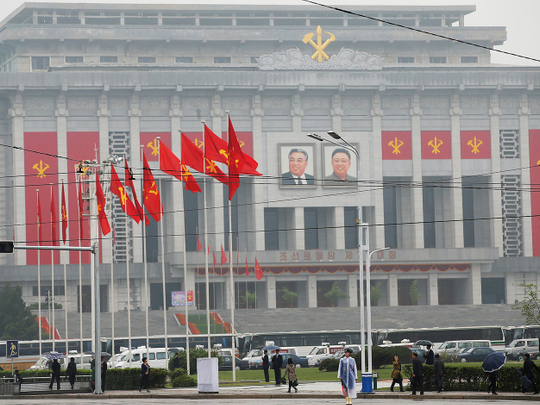
Pyongyang: North Korea on Friday staged its most important political show for a generation, aimed at cementing the absolute rule of leader Kim Jong-un and underlining the sanctions-hit country’s “prestige” as a nuclear power.
The first ruling party congress for nearly 40 years drew thousands of selected delegates from across the country to Pyongyang for what, in theory at least, was a gathering of North Korea’s top decision-making body.
The 33-year-old Kim, who was not even born when the last Workers’ Party Congress was held in 1980, was to deliver a keynote address that will be scrutinised for any sign of a substantive policy shift, especially on the economic front.
Analysts will also be watching for personnel changes as Kim looks to bring in a younger generation of leaders hand-picked for their loyalty.
State media previewed the event by hailing the North’s most recent nuclear test in January as evidence of its “greatness and prestige as a nuclear power state.”
And the North’s Committee for the Peaceful Reunification of Korea slammed the international community’s opposition to Pyongyang’s nuclear weapons programme.
“Regardless of whether someone recognises it or not, our status as a nuclear state that is armed with H-bombs cannot change,” the committee said in a statement.
The 1980 congress was staged to crown Kim’s father Kim Jong-il as heir apparent to his own father, the North’s founding leader Kim Il-sung.
The 2016 version was being held inside the imposing April 25 Palace, whose stone facade was adorned with huge portraits of the two late leaders, along with giant red and gold ruling party banners.
The more than 100 invited foreign journalists were not allowed inside and were restricted to watching from a spot 200 metres away in the light drizzle falling on the capital.
State television provided no live coverage of the congress itself, devoting its morning programming to archive material, films and patriotic concerts.
While the agenda — and even the duration — of the congress remains unknown, its main objective is to confirm Kim’s status as legitimate inheritor of the Kim family’s dynastic rule which spans almost seven decades.
It may also enshrine as formal party doctrine Kim’s “byungjin” policy of pursuing nuclear weapons in tandem with economic development.
The North Korean capital was immaculately primped and primed for the congress, with national and Workers’ Party flags lining its broad rainswept streets, along with banners carrying slogans such as “Great comrades Kim Il-sung and Kim Jong-il will always be with us”.
Preparation involved mobilising the entire country in a 70-day campaign that New York-based Human Rights Watch denounced as a mass exercise in forced labour.
The foreign media was accompanied by official minders, and passers-by who agreed to be interviewed stuck closely to the official line.
Office worker Kim Hyang, 26, said the North’s nuclear arsenal was the unavoidable product of US aggression.
“We must have nuclear weapons because the US and its followers want to stifle us,” Kim said.
“They threaten the North with nuclear weapons, so if we are to defend our sovereignty, peace and security, we must have nuclear weapons,” she added.
Since Kim took power after the death of his father in December 2011, North Korea has carried out two nuclear tests and two successful space rocket launches.
Even as the international community responded with tougher sanctions, Kim pressed ahead with single-minded drive for a credible nuclear deterrent with additional missile and technical tests.
He also demonstrated a ruthless streak, purging the party, government and powerful military of those seen as disloyal, and ordering the execution of his powerful uncle, and one-time political mentor, Jang Song-Thaek.
There has been widespread speculation about the North preparing another nuclear test to coincide with the congress, as a defiant gesture of strength and intent.
Analysing the most recent satellite pictures of the test site at Punggye-ri, the US-Korea Institute at Johns Hopkins University on Thursday said there was no clear evidence one way or the other of whether an underground test was imminent.












